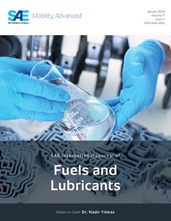The Leaner Lifted-Flame Combustion (LLFC) strategy offers a possible alternative to low temperature combustion or other globally lean, premixed operation strategies to reduce soot directly in the flame, while maintaining mixing-controlled combustion. Adjustments to fuel properties, especially fuel oxygenation, have been reported to have potentially beneficial effects for LLFC applications. Six fuels were selected or blended based on cetane number, oxygen content, molecular structure, and the presence of an aromatic hydrocarbon. The experiments compared different fuel blends made of n-hexadecane, n-dodecane, methyl decanoate, tri-propylene glycol monomethyl ether (TPGME), as well as m-xylene. Several optical diagnostics have been used simultaneously to monitor the ignition, combustion and soot formation/oxidation processes from spray flames in a constant-volume combustion vessel. Ignition delay times, lift-off lengths and soot KL extinction levels for the six fuels have been measured at in-cylinder conditions relevant to modern diesel engines.
The results show that blending an alkane with an oxygenated fuel of similar cetane number has no noticeable impact on ignition delay while only slightly affecting lift-off length, with longer flame stabilization distance for blends with higher oxygen content. Longer ignition delays and lift-off lengths were observed when m-xylene was added to an oxygenated blend. Methyl decanoate showed both longer ignition delays and longer lift-off lengths than the other fuels, consistent with its lower cetane number. These experiments show that there is no direct linear relationship between ignition and flame stabilization when burning fuels with different chemical compositions. Blends using TPGME as oxygenated component achieved lower soot levels compared to methyl decanoate, with the best performance as soot is concerned being achieved with a 50/50 blend of TPGME and n-hexadecane. Aromatic hydrocarbons (here m-xylene), rather than paraffinic hydrocarbons, blended with an oxygenated fuel can negate the benefit of oxygenation with regard to a reduction in soot levels, despite producing longer lift-off lengths.
